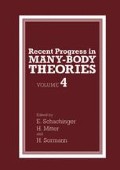Abstract
The elastic scattering cross sections of electrons by atoms and of nucleons by nuclei are very accurately reproduced by assuming that the incident particle only feels a one-body potential, called the optical potential. The agreement between the calculated and experimental cross sections is so good that some authors adopt the viewpoint that the optical potential could be determined with unlimited accuracy if the exact elastic cross sections were known. However, starting from some given optical potential, one can always construct other potentials which would leave the phase shift unchanged but would modify the scattering wave function at finite distance. Thus, the problem of defining the “optical wave function” of the scattered particle should be treated on a par with that of defining the microscopic optical potential.
Access this chapter
Tax calculation will be finalised at checkout
Purchases are for personal use only
Preview
Unable to display preview. Download preview PDF.
References
S. Frullani and J. Mougey,Adv. Nucl. Phys. 14:1(1984).
I.E. McCarthy and E. Weigold,Reports Progr. Phys. 54:789(1991).
F. Capuzzi and C. Mahaux, Ann. Phys. (N. Y.) in press.
J.M. Bang, F.G. Gareev, W.T. Pinkston, and J.S. Vaagen,Phys. Reports 125:253 (1985), and references contained therein.
W. Von Niessen, J. Schirmer, and L.S. Cederbaum,Computer Physics Reports 1:58(1984).
H. Feshbach,Ann. Phys. (N. Y.) 19:287(1962).
J.S. Bell and E.J. Squires,Phys. Rev. Lett. 3:96(1959).
C. Mahaux and R. Sartor,Adv. Nucl. Phys. 20:1(1991).
K. Gottfried, in: “Elementary Particle Physics and Scattering Theory”, Vol. 2, M. Chrétien and S.S. Schweber, ed., Gordon and Breach Science Publ., New York, (1970) p. 125.
Author information
Authors and Affiliations
Editor information
Editors and Affiliations
Rights and permissions
Copyright information
© 1995 Springer Science+Business Media New York
About this chapter
Cite this chapter
Mahaux, C. (1995). Microscopic Theories of Atomic and Nuclear Optical Potentials. In: Schachinger, E., Mitter, H., Sormann, H. (eds) Recent Progress in Many-Body Theories. Springer, Boston, MA. https://doi.org/10.1007/978-1-4615-1937-9_17
Download citation
DOI: https://doi.org/10.1007/978-1-4615-1937-9_17
Publisher Name: Springer, Boston, MA
Print ISBN: 978-1-4613-5794-0
Online ISBN: 978-1-4615-1937-9
eBook Packages: Springer Book Archive

